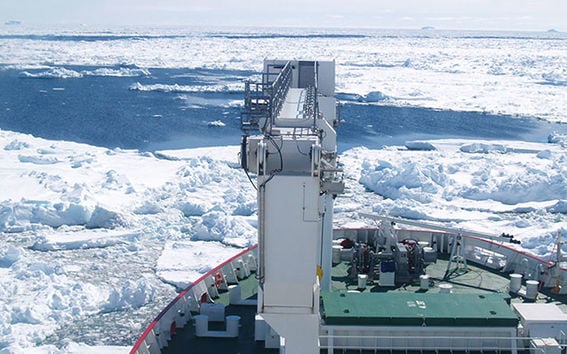Professor John Dempsey, a prominent researcher of sea ice fracture

Industrial activity in the Arctic marine areas is increasing. Construction of wind power in areas in which the sea freezes over is in the horizon, and the shrinking of the ice cap opens new traffic routes and opportunities to exploit natural resources in northern regions. The Arctic is a challenging environment and a high level of efficiency and security is required from ships and offshore structures that operate in the area, which demands in-depth understanding of loads caused by sea ice. The aim of the Aalto University project Scaling of Ice Strength: Measurements and Modeling (ICESCALE) is to find answers to challenges in seafaring in the Arctic.
Aalto University has invited Professor John Dempsey (Clarkson University, USA), one of the leading researchers of sea ice fracture, to be a FiDiPro professor in 2015–2018. Professor Dempsey has unique experience in experimental research on sea ice fracture. He has lead several successful field campaigns to northern marine areas and to the Antarctic.
Dempsey, who is on sabbatical, arrived in Finland in May. Aware of the work conducted by the ice technology group at Aalto University, he decided to accept the FiDiPro professorship at Aalto University.
- I held the work done here by Arttu Polojärvi, Jukka Tuhkuri ja Pentti Kujala in high esteem. I also knew about the Aalto Ice Tank. At home in the USA, many people were wondering why I would want to go to north for my sabbatical, but on the other hand, my research focuses on ice, says Dempsey.
Professor Dempsey has previously spent his sabbaticals in Cambridge, Zurich, Singapore and New Zealand, among other places. According to Dempsey, when on sabbatical, you have to get used to being on your own. However, he does not agree on the familiar prejudices about the Finns.
- It has been very nice here in Finland. For some reason, people regard the Finns as somewhat unfriendly, but my own experiences have been quite the contrary. I think the Finns are reserved rather than unfriendly. My hosts have been nice. I found a good apartment, and I have managed to explore the city. Public transport works well here and getting around is easy.
Many countries have become interested in natural resources in the Arctic, but the United States has decided to withdraw all its drilling projects from the Arctic. However the United States still supports a great deal of research in the Arctic. Research on ice is important because ice is always a challenge in the creation of new structures.
- When we get more information about ice loads and the pressure they cause to structures and ships, we can build new structures more efficiently and economically.
Model ice fracture is examined in the Aalto Ice Tank. Hardly any research has been carried out on model ice fracture from the perspective of fracture mechanics.
- It is interesting that exploiting fracture mechanics in the research of model ice has already been discussed for forty years. It is unbelievable that still no one has done it. What we want to do in the ICESCALE project is to examine how fresh water ice and ethanol ice fracture in the tank. Then we want to develop modelling methods in order to better understand fracturing of ice and the effect of ice loads on a realistic scale. Our aim is to be able to forecast ice loads better than any other laboratory in the world. The entire project is very ambitious.
According to Professor Dempsey, there would also be demand for research on Baltic Sea ice. The Baltic Sea is a marine area with a relatively low salt content and therefore the properties of its ice may be different compared with ice in fresh water and normal sea water.
The ICESCALE project has been divided into three parts between 2015 and 2018. The aim of the project is to produce scientific information related to ice fracture and ice mechanics as well as to create a new approach closely related to fracture mechanics for interpreting the laboratory test results and transferring them to full scale performance.
Industrial application of the project's results is linked to more efficient and more exact design processes of ships and offshore structures designed for marine areas that freeze over. Operators in Arctic technology in Finland will benefit from the results: designers, builders and users of ships and structures as well as the authorities.
If successful, the ICESCALE project will turn Aalto Ice Tank into an even stronger research environment that will attract more international researchers to Finland. Collaboration with Professor Dempsey will strengthen research on Arctic technology at Aalto University and its appreciation internationally. Additionally, the collaboration will enable dissemination of his knowledge and experience among the operators in the field of Arctic technology in Finland. The Finnish government is also interested in the Arctic region and the ICESCALE project will improve Finland's status as an Arctic expert.
Contact information
Professor John Dempsey
Read more news

Get to know us: Associate Professor Maria Sammalkorpi
Sammalkorpi received her doctorate from Helsinki University of Technology 2004. After her defence, she has worked as a researcher at the Universities of Princeton, Yale and Aalto.
Aalto computer scientists in ICML 2024
Computer scientists in ICML 2024
Getting bacteria into line
Physicists use magnetic fields to manipulate bacterial behaviour